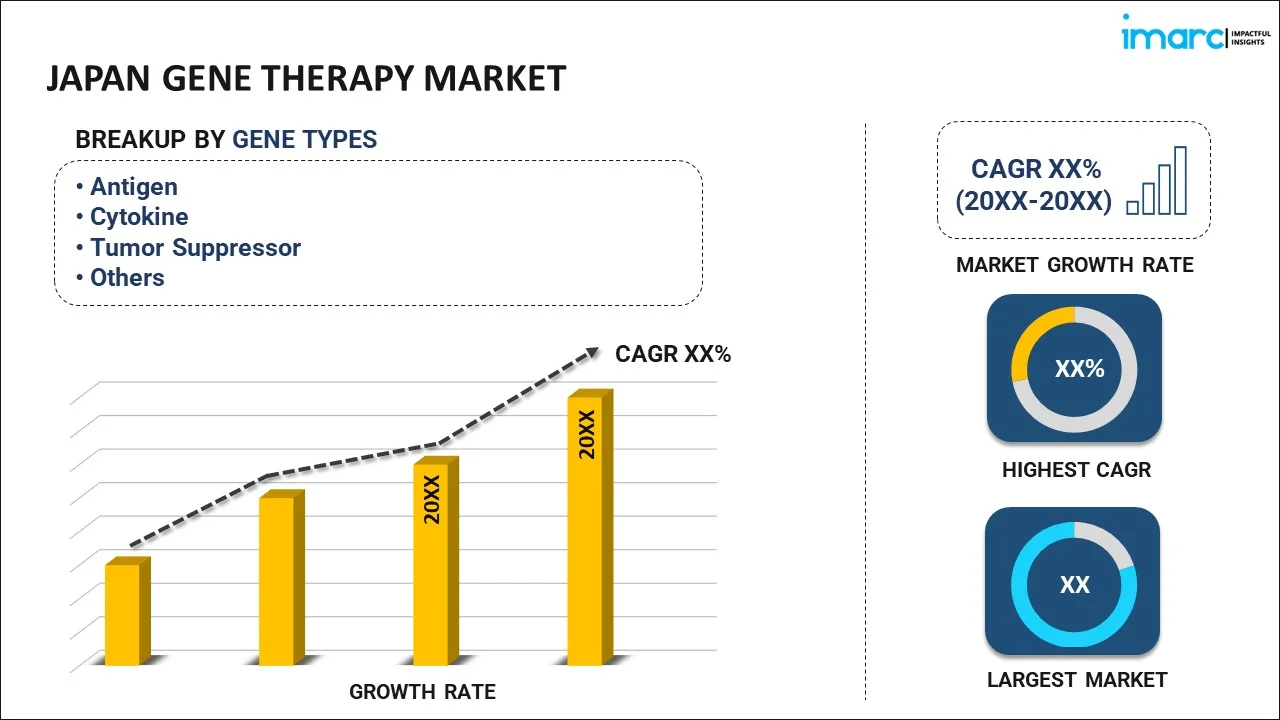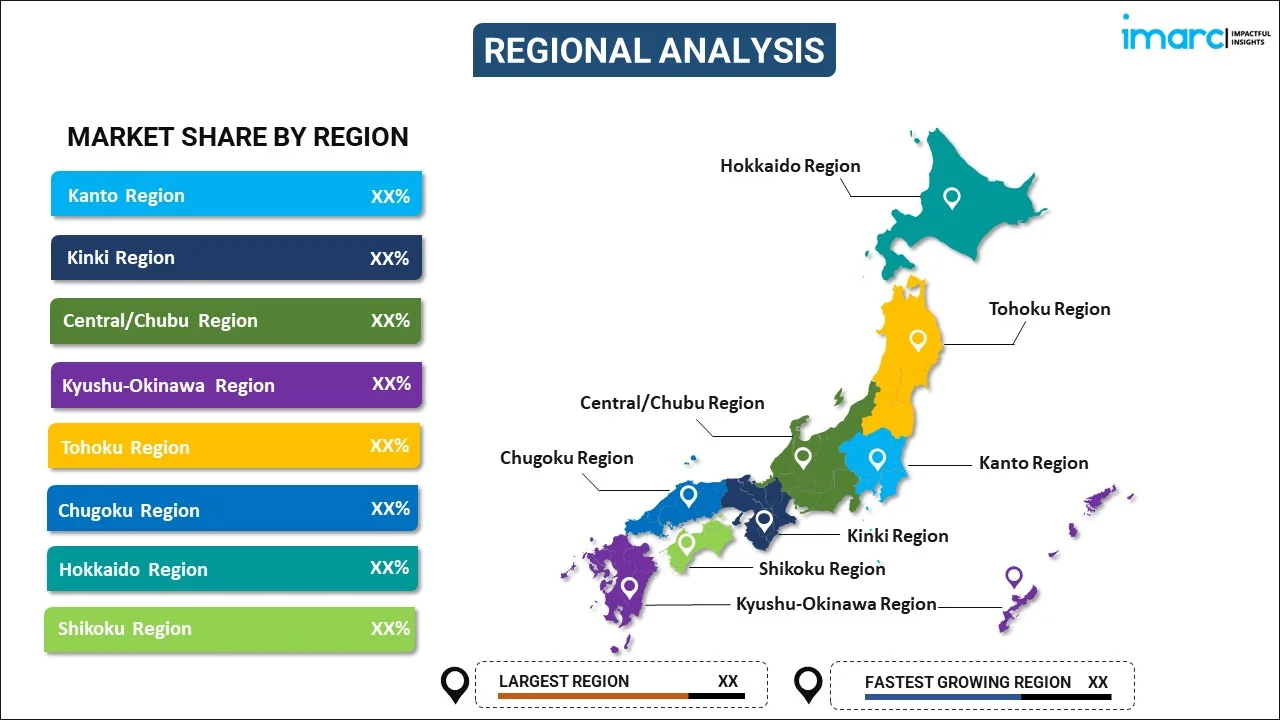
Japan Gene Therapy Market Report by Gene Type (Antigen, Cytokine, Tumor Suppressor, Suicide Gene, Deficiency, Growth Factors, Receptors, and Others), Vector Type (Viral Vector, Non-Viral Techniques), Delivery Method (In-Vivo Gene Therapy, Ex-Vivo Gene Therapy), Application (Oncological Disorders, Rare diseases, Cardiovascular Diseases, Neurological Disorders, Infectious Disease, and Others), and Region 2025-2033
Market Overview:
The Japan gene therapy market size is projected to exhibit a growth rate (CAGR) of 14.2% during 2025-2033. The escalating prevalence of genetic disorders, recent advancements in gene editing technologies, implementation of supportive policies by the Government of Japan, and the increasing investment in research and development (R&D) represent some of the key factors driving the market.
|
Report Attribute
|
Key Statistics
|
|---|---|
|
Base Year
|
2024
|
|
Forecast Years
|
2025-2033
|
|
Historical Years
|
2019-2024
|
| Market Growth Rate (2025-2033) | 14.2% |
Gene therapy is a groundbreaking approach in the medical field, designed to address and potentially eradicate diseases through the modification of genes within an individual's cells. This advanced technique encompasses the introduction, deletion, or alteration of genetic material in a patient's cells, with the primary aim of rectifying the genetic anomalies causing various diseases. The essential components of gene therapy include therapeutic deoxyribonucleic acid (DNA), a delivery vector that facilitates the transfer of DNA into cells, and sophisticated gene-editing technologies, such as CRISPR. It finds application across numerous domains, including cancer treatment, management of viral infections, tackling cardiovascular diseases (CVDs), neurological disorders, autoimmune diseases, age-related illnesses, specific types of blindness, and genetic disorders, including hemophilia, cystic fibrosis, and sickle cell disease.
Japan Gene Therapy Market Trends:
The escalating prevalence of genetic disorders and cancers in Japan, which has prompted the need for innovative treatment methods, such as gene therapy, is propelling the market growth. Additionally, the recent advancements in gene editing technologies such as CRISPR/Cas9, which have improved the accuracy of gene modifications and enhanced the success rates of therapies, are contributing to the market growth. Furthermore, the substantial investments in research and development (R&D) activities by pharmaceutical and biotech companies to develop effective and innovative gene therapies are boosting the market growth. Along with this, the implementation of supportive regulations and policies by the Government of Japan to accelerate approval processes and promote gene therapy trials and products is stimulating the market growth. Besides this, the emergence of advanced vector delivery systems, which improve gene therapy's efficacy and minimize potential side effects, thus ensuring more effective and safer treatment options, is supporting the market growth. Moreover, the heightened awareness about gene therapy and its potential benefits among healthcare professionals and patients is strengthening the market growth. Apart from this, the growing strategic alliances and collaborations among universities, research institutions, and companies to boost innovation and broaden the potential for commercialization are catalyzing the market growth. In addition, the escalating geriatric population, which is highly susceptible to various age-related diseases, such as Parkinson's disease, osteoarthritis, Alzheimer's disease, and age-related macular degeneration (AMD), is fueling the market growth. Other factors, including rising healthcare expenditure, growing adoption of precision medicines, and increasing demand for innovative therapies, are anticipated to drive the market growth.
Japan Gene Therapy Market Segmentation:
IMARC Group provides an analysis of the key trends in each segment of the Japan gene therapy market report, along with forecasts at the country levels for 2025-2033. Our report has categorized the market based on gene type, vector type, delivery method, and application.
Gene Type Insights:

- Antigen
- Cytokine
- Tumor Suppressor
- Suicide Gene
- Deficiency
- Growth Factors
- Receptors
- Others
The report has provided a detailed breakup and analysis of the Japan gene therapy market based on gene type. This includes antigen, cytokine, tumor suppressor, suicide gene, deficiency, growth factors, receptors, and others.
Vector Type Insights:
- Viral Vector
- Adenoviruses
- Lentiviruses
- Retroviruses
- Adeno-Associated Virus
- Herpes Simplex Virus
- Poxvirus
- Vaccinia Virus
- Others
- Non-Viral Techniques
- Naked and Plasmid Vectors
- Gene Gun
- Electroporation
- Lipofection
- Others
A detailed breakup and analysis of the Japan gene therapy market based on the vector type has also been provided in the report. This includes viral vector (adenoviruses, lentiviruses, retroviruses, adeno-associated virus, herpes simplex virus, poxvirus, vaccinia virus, and others) and non-viral techniques (naked and plasmid vectors, gene gun, electroporation, lipofection, and others).
Delivery Method Insights:
- In-Vivo Gene Therapy
- Ex-Vivo Gene Therapy
The report has provided a detailed breakup and analysis of the Japan gene therapy market based on the delivery method. This includes in-vivo and ex-vivo gene therapy.
Application Insights:
- Oncological Disorders
- Rare diseases
- Cardiovascular Diseases
- Neurological Disorders
- Infectious Disease
- Others
The report has provided a detailed breakup and analysis of the Japan gene therapy market based on the application. This includes oncological disorders, rare diseases, cardiovascular diseases, neurological disorders, infectious disease, and others.
Regional Insights:

- Kanto Region
- Kinki Region
- Central/Chubu Region
- Kyushu-Okinawa Region
- Tohoku Region
- Chugoku Region
- Hokkaido Region
- Shikoku Region
The report has also provided a comprehensive analysis of all the major regional markets, which include Kanto Region, Kinki Region, Central/Chubu Region, Kyushu-Okinawa Region, Tohoku Region, Chugoku Region, Hokkaido Region, and Shikoku Region.
Competitive Landscape:
The report has also provided a comprehensive analysis of the competitive landscape in the Japan gene therapy market. Competitive analysis such as market structure, key player positioning, top winning strategies, competitive dashboard, and company evaluation quadrant has been covered in the report. Also, detailed profiles of all major companies have been provided.
Japan Gene Therapy Market Report Scope:
| Report Features | Details |
|---|---|
| Base Year of the Analysis | 2024 |
| Historical Period | 2019-2024 |
| Forecast Period | 2025-2033 |
| Units | Million USD |
| Scope of the Report | Exploration of Historical and Forecast Trends, Industry Catalysts and Challenges, Segment-Wise Historical and Predictive Market Assessment:
|
| Gene Types Covered | Antigen, Cytokine, Tumor Suppressor, Suicide Gene, Deficiency, Growth Factors, Receptors, Others |
| Vector Types Covered |
|
| Delivery Methods Covered | In-Vivo Gene Therapy, Ex-Vivo Gene Therapy |
| Applications Covered | Oncological Disorders, Rare diseases, Cardiovascular Diseases, Neurological Disorders, Infectious Disease, Others |
| Regions Covered | Kanto Region, Kinki Region, Central/Chubu Region, Kyushu-Okinawa Region, Tohoku Region, Chugoku Region, Hokkaido Region, Shikoku Region |
| Customization Scope | 10% Free Customization |
| Post-Sale Analyst Support | 10-12 Weeks |
| Delivery Format | PDF and Excel through Email (We can also provide the editable version of the report in PPT/Word format on special request) |
Key Questions Answered in This Report:
- How has the Japan gene therapy market performed so far and how will it perform in the coming years?
- What has been the impact of COVID-19 on the Japan gene therapy market?
- What is the breakup of the Japan gene therapy market on the basis of gene type?
- What is the breakup of the Japan gene therapy market on the basis of vector type?
- What is the breakup of the Japan gene therapy market on the basis of delivery method?
- What is the breakup of the Japan gene therapy market on the basis of application?
- What are the various stages in the value chain of the Japan gene therapy market?
- What are the key driving factors and challenges in the Japan gene therapy market?
- What is the structure of the Japan gene therapy market and who are the key players?
- What is the degree of competition in the Japan gene therapy market?
Key Benefits for Stakeholders:
- IMARC’s report offers a comprehensive quantitative analysis of various market segments, historical and current market trends, market forecasts, and dynamics of the Japan gene therapy market from 2019-2033.
- The research study provides the latest information on the market drivers, challenges, and opportunities in the Japan gene therapy market.
- Porter's five forces analysis assist stakeholders in assessing the impact of new entrants, competitive rivalry, supplier power, buyer power, and the threat of substitution. It helps stakeholders to analyze the level of competition within the Japan gene therapy industry and its attractiveness.
- Competitive landscape allows stakeholders to understand their competitive environment and provides an insight into the current positions of key players in the market.
Need more help?
- Speak to our experienced analysts for insights on the current market scenarios.
- Include additional segments and countries to customize the report as per your requirement.
- Gain an unparalleled competitive advantage in your domain by understanding how to utilize the report and positively impacting your operations and revenue.
- For further assistance, please connect with our analysts.
 Inquire Before Buying
Inquire Before Buying
 Speak to an Analyst
Speak to an Analyst
 Request Brochure
Request Brochure
 Request Customization
Request Customization




.webp)




.webp)












